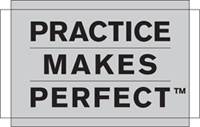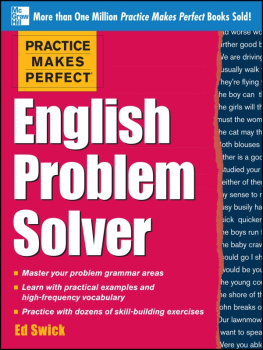Contents
Guide


English
Conversation
Copyright 2016 by McGraw-Hill Education. All rights reserved. Printed in the United States of America. Except as permitted under the United States Copyright Act of 1976, no part of this publication may be reproduced or distributed in any form or by any means, or stored in a database or retrieval system, without the prior written permission of the publisher.
1 2 3 4 5 6 7 8 9 RHR 21 20 19 18 17 16
ISBN 978-1-259-64327-9
MHID 1-259-64327-1
e-ISBN 978-1-259-64326-2
e-MHID 1-259-64326-3
McGraw-Hill Education, the McGraw-Hill Education Publishing logo, Practice Makes Perfect, and related trade dress are trademarks or registered trademarks of McGraw-Hill Education and/or its affiliates in the United States and other countries and may not be used without written permission. All other trademarks are the property of their respective owners. McGraw-Hill Education is not associated with any product or vendor mentioned in this book.
McGraw-Hill Education products are available at special quantity discounts to use as premiums and sales promotions or for use in corporate training programs. To contact a representative, please visit the Contact Us pages at www.mhprofessional.com.
McGraw-Hill Education Language Lab App
Audio recordings of all the Conversations in this book are available to support your study. Go to www.mhlanguagelab.com to access the online version of the application, or to locate links to the mobile app for iOS and Android devices. (Note Internet access is required to access audio via the app). More details about the features of the app are available on the inside front cover.
Contents
Preface
Practice Makes Perfect: English Conversation is designed to give you practice with the vocabulary and structures that are most often used in common types of informal conversations.
The book consists of thirteen chapters, each one devoted to a particular conversational function. Each chapter begins with a typical conversation followed by a discussion of vocabulary and structures that are particularly important for the type of conversation being addressed. Certain expressions are repeated in other chapters so that you will become more familiar with them as they occur in different contexts. Following the discussion section are several sets of exercises to help you feel confident that you understand the material. The exercises also give you practice in using new vocabulary and structures so that you will be able to include them in your personal conversations.
Use this book, practice your English in conversations with your English-speaking friends, and continue to enjoy this language.
1
Introducing yourself and others
Conversation: Meeting at a party
TODD: Hiyou must be Johns cousin Matt, right? From San Diego?
MATT: Correct! I just got in last night.
TODD: Im Todd, Johns roommate from Tech. Glad to meet you. I can assure you that Im not anything like what John has told you.
MATT: Im happy to meet you, tooand, yesI have heard about you! Football player and party animal extraordinaire.
TODD: Football, yesand as a matter of fact, I do like parties. But tell me more about yourself and what you do in San Diego.
MATT: Well, Im more (of) a surfer than a football player. You know, San Diego has a fantastic coastand we can surf all day and then party on the beach at night.
TODD: That sounds awesome. How long are you staying?
MATT: Well, Ill be here for two weeks. John has promised me a nonstop schedulekind of a mix of sightseeing, meeting his friends, checking out the local scene, andhopefullycamping in the mountains for a couple of days.
TODD: Johns a good guyand you can be sure he knows the local scene. He knows everybody in town. Im sure hell show you a good time. And his friends are here to help.
MATT: Thanks so muchI really appreciate that. Im still a bit jet-lagged at the moment but should be in good shape by tomorrow. Im looking forward to hearing what John has in store for me.
TODD: Dont worry. Well all take good care of you. And dont be surprised if we show up on your doorstep in San Diego one day, ready for surfing!
Improving your conversation
Im Todd (Jones)
Simply using Im and then saying your name is one way to introduce yourself. You could also say, for example, My names Todd (Jones). It is customary to offer your right hand in a handshake to the other person. In very informal situations, you could just say Hi, Im Todd, with no handshake.
To introduce one or more people other than yourself, say:
This is (my wife,) Mary. And this is Susan, Bob, and Joe.
To introduce more than one person and also tell how you know them, say:
These are my friends, Susan and Bob. And this is Jim, my coworker.
All of the people introduced would then shake hands. You could also say:
I want you to meet (my friends,) Susan and Bob.
Glad/happy to meet you
When you have been introduced to someone, it is customary to say (Im) glad/happy to meet you or Its nice to meet you. The reply is Im happy to meet you or Im happy to meet you, too . (The underlined words are pronounced slightly louder than the others.)
Right?
Right? is an informal way to ask for confirmation that what you have just said is true. The answer can be Thats right!
This train goes to Washington, right? | Thats right. |
Youre from Panama, right? | Thats right, I am. |
Correct!
This is an informal answer to a question that asks for confirmation.
Youre Matt, arent you? | Correct! |
This is Economics 101, right? | Correct! |
If you want to tell your questioner that he or she is not correct, you can politely say this with, for example:
No, thats not right .
No, thats not correct .
No, Im not Matt ; Im Jim .
No, she isnt my sister . Shes my cousin .
(The underlined words in the examples should be spoken slightly louder than the other words in the sentence.)
To sarcastically indicate that something is not correct, Yeah, right! is used.
Dylan, I heard you just won the lottery jackpot! | Yeah, right! Where did you hear that nonsense? |
Am, do, etc.
When a yes-or-no question using the verb to be is asked, the answer can be made emphatic by following it with a tag, in which, if the answer is yes, the verb is said a little louder than the other words. Affirmative tag answers are not contracted.











